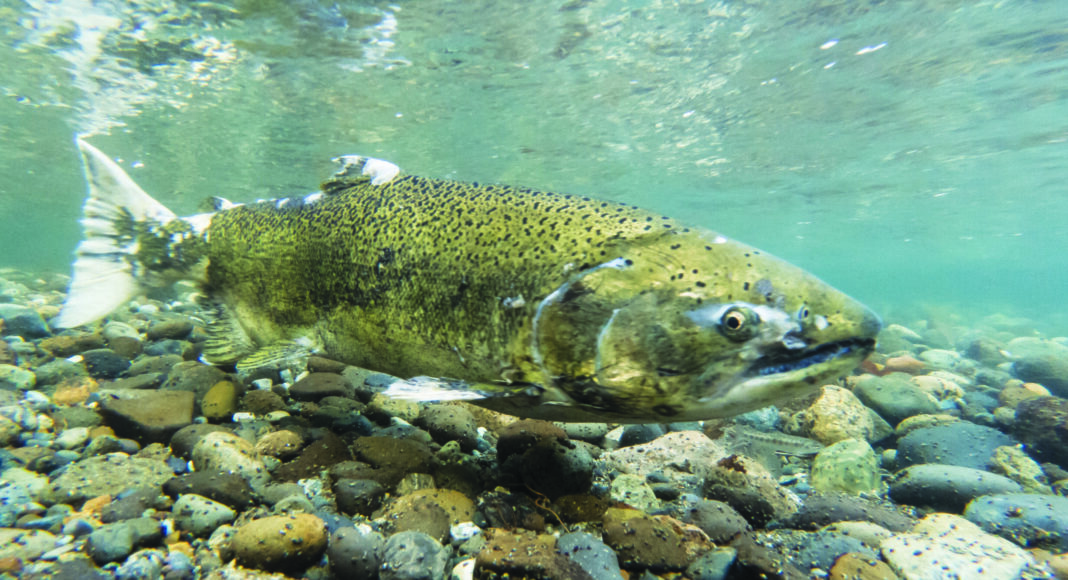Salmon population numbers in key California stocks are forecasted to be lower than they have been in years, prompting a full closure of the ocean fishery for the first time since 2008/2009.
The Pacific Fishery Management Council (PFMC) determines ocean salmon seasons for Washington, Oregon and California. The council is currently weighing three management alternatives for the 2023 season. These alternatives vary for Washington and Oregon, but none allows commercial or recreational salmon fishing in California until at least April 2024.
The PFMC will accept public comments on the alternatives this week and at a meeting in Foster City from April 1-7. The council will adopt one of the three regulations at the April meeting and forward the recommendation to the National Marine Fisheries Service, which will make a final call by May 16.
Plummeting Populations
The closure comes on the tail of annual pre-season abundance forecasts. Researchers use catch numbers and the amount of fish returning to rivers to create models that predict fish numbers for the coming season. In March, those numbers looked worse than they have in over a decade for two key stocks.
Sacramento River fall Chinook was forecasted to have 169,767 adults, while Klamath River fall Chinook was forecasted to have 103,793 adults. Managers say the causes for the declines are complex.
(The coho salmon in Santa Cruz County streams are not what people are fishing for in Monterey Bay. The California industry focuses on Chinook, also known as king salmon.)
“I’m hesitant to speculate as to what the primary cause was because it’s pretty clear that there’s a number of things going on—both in freshwater and in the ocean—that resulted in what we’re looking at today,” says Michael O’Farrell, the program lead of the fisheries assessment modeling at the National Oceanic and Atmospheric Administration (NOAA) Southwest Fisheries Science Center in Santa Cruz.
But whatever the major causes, the drought certainly didn’t help.
“This is a decades-long trend, and the past few years of record drought only further stressed our salmon populations,” said Charlton H. Bonham, director of the California Department of Fish and Wildlife (CDFW), in a press release about the closure.
Chinook salmon follow about a three-year cycle, during which they hatch in a river, migrate to the ocean and spend a few years at sea before returning to their home stream to spawn and die, so environmental conditions from a few years ago determine the population that returns now.
“Three years ago, we were dealing with intense drought that dried up rivers, as well as climate disruption,” says Jordan Traverso, the deputy director of communications at CDFW. “We also have major issues with barriers to passage in their historic habitat, with dams preventing them from utilizing hundreds of miles of it.”
Fisherman Panic
The closure feels like a final blow for some local fishermen who depend on salmon. Kevin Butler, who has fished salmon commercially in Monterey Bay since 2002, calls it devastating.
“We didn’t have a crab industry, our harbor was shoaled up for three months, no one has made money in years and the last couple years, they gave us these little spots [to fish],” he says.
Drops in restaurant sales during the pandemic, increasing costs and closed fisheries are forcing people who have been in the industry for decades to reconsider their careers—particularly, Butler says, if they operate smaller boats.
“I don’t have anything else to fall back on,” he says. “I’m going to get my captain’s license and try to start doing eco-tours, but other than that ….”
Despite the challenges, Butler says he supports a closure for at least two years so that people can’t blame the salmon declines on fishermen.
“We didn’t do it,” he says, pointing instead toward water management and hatcheries.
CDFW says the problem is more complex.
“Water management is part of the salmon strategy, but there is more to the story,” Traverso says. “It’s really easy for groups advocating for one small piece of the story to boil it down to this age-old—and tired—debate. But the whole story is so much more vast.”
The good news, he says, is that salmon numbers fluctuate, and conditions this year are better.
“We anticipate that the fish born this year will have better success,” says Traverso.
Hope for Recovery
The recent storms, though destructive in many other ways, aid current salmon in getting to the sea and back.
“I think [the rains] can only help right now,” O’Farrell says. “Better than drought conditions, that’s for sure.”
CDFW is taking advantage of higher water levels to release millions of smolt—young salmon ready to migrate to the sea—from hatcheries into streams around California. But because of the salmon life cycle, it will be a few years before biologists and fishermen see the results.
Another strategy for bolstering the population is the removal of dams around the state. In what Traverso calls “the largest river restoration project in American history,” four tribal water projects will remove four dams along the Klamath River, giving salmon and steelhead access to almost 400 more miles of watershed in California and Oregon.
Still, managers, scientists and fishermen remain cautious in their hopes for a normal season soon.
“Salmon management goes on a year-by-year basis,” O’Farrell says. “We go through this process every year of making abundance forecasts and planning the salmon seasons, and salmon populations can be pretty variable. So, I’d hesitate to be too confident about what we’re looking at for next year. But salmon are resilient, and so you never know.”




Whew